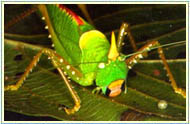Pipers and Ants, a Mini Ecosystem
Ecologists like Lee and Grant study very small ecosystems consisting of a single plant and the interactions of organisms dependent on that plant. One such "mini ecosystem" is the community of insects and other arthropods that live on Piper cinocladum, a species of Piper plant.
Piper plants are common at La Selva. You can find many different kinds along the trails in varied forest environments. Some Pipers are trees and others shrubs, but they are all easily identified by their knobby nodes and flowers that look like small skinny white candles.
Although Piper plants produce toxic substances, they are home and food for a large number of different creatures, including some caterpillars, beetles, and ants.
 |
 |
 |

The katydid feeds off both ants and caterpillars on the Piper plant.
|
 |
 |
 |
The Piper plant is home to a species of small ants called "cleaner ants." The plant not only provides these ants with a home but it also makes them food! How does this work?
A hollow part of the leaf that attaches to the stem provides a place for the ants to lay their eggs. If you cut open this area, you might also find many little white food bodies. These are made by the plant and contain many of the nutrients the ants need to live. Amazingly, the plant makes to food just for the ants. We know this because if there are no ants living in that space, the plant does not make as much food, but when there are ants there, the plant makes more food.
So what does the plant get out of it? The ants patrol the leaves and clean off the surfaces. If they find caterpillar eggs, they will either eat them or throw them off though some caterpillars do manage to evade the ant patrol.
The story gets even more complicated. There are beetles that lay their eggs on these plants. The eggs are protected from the ants by a web. When the beetle eggs hatch, the growing grub chews through the web and kills the ants and their eggs. Yet, somehow, this beetle (who doesn't clean the leaves like the ant) also causes the plant to make more food bodies. All total, there are over 50 species of arthropods that are part of this mini-ecosystem!

